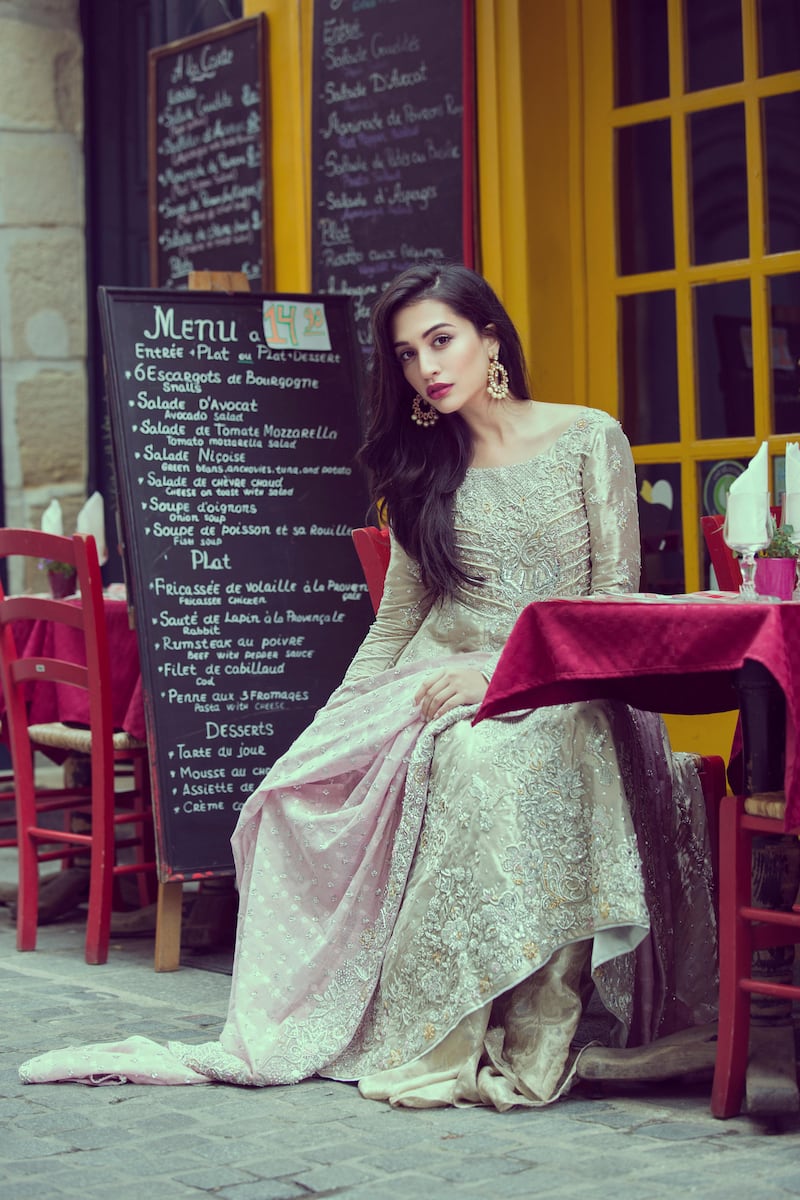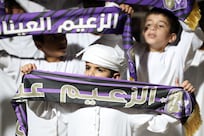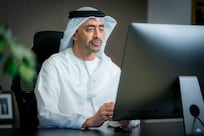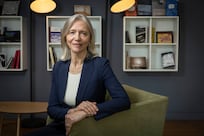Salade d'avocat and soupe d'oignons are among the menu items listed on a chalkboard outside a quaint street-side restaurant in Paris. On a red chair sits a young woman robed in a traditional ivory-coloured South Asian outfit, with a light pink dupatta, or scarf. The ensemble, which is covered with hand-sewn crystals and metallic embroidery, is a bridal couture design by Pakistani fashion label Ansab Jahangir, photographed by Muzi Sufi and modelled by one of Pakistan's top models, Sana Ansari.
Ansari, who now lives in the UAE, started modelling in Karachi at the age of 15. "One of my friends was interning as a photographer at a modelling agency during the summer break and she asked me to come in for fun to shoot a portfolio. When the agent saw me, he said: 'This girl has potential, so call her again and get a proper portfolio done.' And then, within two weeks, I got my first commercial booking," she says.
Shortly afterwards, Ansari was signed on as a face of Coca-Cola in Pakistan, and starred in commercials for telecommunications companies like Jazz and Telenor. But luxury ethnic fashion is where the young model found her forte. She worked, and continues to work, with some of Pakistan's top fashion houses, including Elan, Sana Safinaz and Farah Talib Aziz. She is frequently featured on the covers of fashion magazines and tabloids like Grazia Pakistan, The Tribune Edit, Paperazzi and Sunday Times. Many of her ethnic shoots see her decked out in marigold garland jewellery, or alongside regal white ponies. A campaign she appeared in for fashion label Saira Rizwan was shot at Rohtas Fort, a World Heritage Site in the Punjab province.
While still living in Karachi, Ansari flew to Abu Dhabi to shoot Ansab Jahangir bridal wear at the capital's Qasr Al Sarab Desert Resort by Anantara, and then journeyed to Paris this summer with the label again. She has also travelled to Thailand multiple times for various commercials and shoots.
But modelling was never a career aspiration for the young Pakistani. "As a child, when anyone would ask me what I wanted to study, I'd always say law – it was just so instilled in my mind." Today, Ansari works full-time in corporate law at a major accounting firm in Dubai, while trying to maintain her modelling career on the side.
____________________
Read more:
[ Is modest modelling an oxymoron? ]
[ From Copenhagen to Kabul, the fashion events you need to know about ]
[ Call for change: how our fashion choices affect the environment ]
____________________
Most of the jobs she does are for Pakistan-based clients, rather than clients in the UAE. Ansari explains that the modelling industry here is not particularly appealing to women who have experience in the industry in her native country. "I had heard some top models from Pakistan moved here in the past, and that when they came, it was hard to find proper work since the pay is a lot lower," she says. "I had the same reaction – the commercials and advertisements that I was being approached for weren't very good brands. And the pay was horrible, absolutely horrible."
In Pakistan, models are paid per outfit in a shoot, rather than the UAE standard, where they tend to receive a flat rate of around Dh1,500 per day. Ansari reveals that in her home country, successful models earn at least three to five times more than this, and they're generally treated with more consideration, too. For instance, while the international norm often sees models changing clothes in the presence of male photographers and crew members, that's not the case in Pakistan. "The men are very respectful," she says. "At fashion shows, there are different male and female changing rooms. But it also depends on how the models act – some are comfortable changing in front of everyone."
While Ansari's immediate family is supportive of her modelling career, she has faced some resistance from her relatives. "The modelling industry in Pakistan – or anywhere, does not have a very good reputation," she says, "but when you actually work in the field as a photographer, make-up artist or model, you realise it isn't as bad as people make it out to be."
Ansari, a practising Muslim, has limits when it comes to baring skin for the camera. "There are restrictions. Obviously no bikinis or shorts, or things like that," she says. "Wearing them in your personal life is different than shooting them – you have to understand that the Pakistani mindset is still on the conservative side, so they would not appreciate that, and neither would my parents."
When Ansari got married last year, she and her husband lived between the UAE and Pakistan, and for a short while in Los Angeles, before finally settling in Dubai in October. Due to her fame, Ansari often gets recognised in public, and is often contacted by fans on social media. "If I ever put an update on Instagram Stories, I get a lot of messages from fans saying 'we're here, please meet us', or something like that. I generally don't respond to those – but if somebody comes up to me and says 'you're Sana Ansari, can we take a picture with you', then of course I'm open to that."
However, fan reactions can sometimes be unsettling – for example, Ansari has spotted people sneakily filming her while she eats at restaurants. And while she recognises that fame might become problematic if she were more widely-known, Ansari says that so far, she's enjoying it. "It's always fun and amazing when people appreciate your work, and you feel really good about yourself."
The model comes across as down-to-earth and charismatic. "I think it's a lot to do with how my parents raised me," she says. "They never let me get too high on my horse."
While it may all look very glamorous, and jobs from Pakistan-based clients may be more rewarding than UAE assignments, at least in Ansari's case, the highs and lows of the career are similar across the board. Her shoot in Paris began at 5am, and lasted for around 12 hours, with the team moving from location to location. "I changed in the car, which was very uncomfortable. And outside, it was freezing," she recalls.
The resulting images are breath-taking. In one, she wears a floral embroidered lehenga, or long skirt, with a bronze halter choli, or cropped blouse, in front of the Eiffel tower. Another shows the model robed in a rich red and mustard outfit on a fairground carousel, and dressed in an ethereal off-white ensemble, by the Louvre.
"Since I started working in Dubai, I've cut down my modelling a lot, because it's very difficult for me to take days off and travel for shoots," she says. But Ansari hopes to keep it up part-time – with perks such as magazine covers and weekends in Paris, who wouldn't?





